How to grow horseradish – expert tips on growing this spicy root
Find out how to grow horseradish for homegrown crops and condiments that deliver a real kick
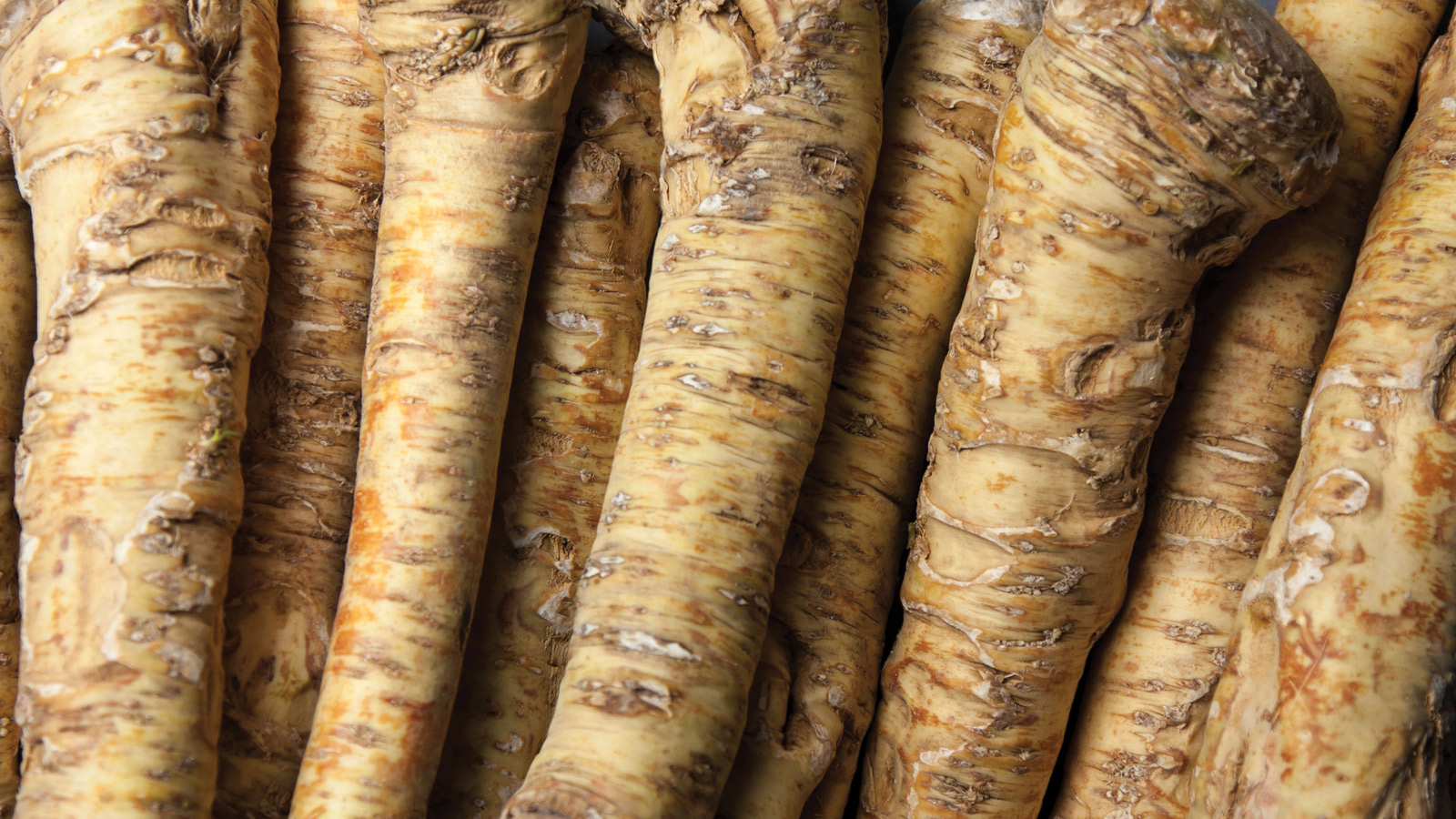

Holly Reaney
Knowing how to grow horseradish gives you the chance to liven up your kitchen garden with one of the most easy-going hale and hearty veggies around. Gnarled and nobbly it may be, but this spicy stalwart is worthy of a spot on any plot.
Part of the same family as mustard, horseradish (Armoracia rusticana) is harvested primarily for its fiery roots with their eye-wateringly peppery payloads. You may recognize it as the condiment used to add a dash of fire to roast beef sandwiches and bloody Mary mix. But did you know how easy it is to grow your own?
Packed with vitamins, minerals, folates and fibers, horseradish is renowned for its antibacterial and healing properties, helping to lower blood pressure, detoxify blood and even prevent cancer. Pound for pound, it is loaded with more vitamin C than oranges. Indeed, given its long tradition of medicinal benefits, it is often regarded more as a herb than a vegetable. Yet despite its intense flavors and nutritional potency, cultivating this vibrant perennial is simplicity itself. So if you want to add a little heat to your vegetable garden ideas, look no further. All you need is sunshine and well-draining soil, and you too can give crops a kick with this free-spirited firestarter.

Horseradish is grown as a veg and a herb and you can even eat the leaves

Janey has been assistant editor of Amateur Gardening magazine for five years. She has taken an active role in a series of conservation, urban renewal and rewilding projects for the RHS and TCV. She has been gardening from an early age, when her mum had her deadheading hydrangeas, mulching roses and propagating strawberry plants from runners for school open days. Here she explains how to give horseradish the best start and how to best control it so it doesn’t impact nearby crops.
Ideal conditions to grow horseradish
Anyone with a spare sheltered sunny spot or a place with partial sun and shade will find it pretty easy to grow horseradish (or pepper root, as it is also known). Thanks to the gutsy way in which this crop’s roots spread underground, you won’t need much in the way of prep for plants to flourish.
Growing horseradish is simple if the soil is well-draining, rich and neutral or slightly acidic, with a pH of 6-7.5. These robust root veggies are some of the easiest vegetables to grow in hardiness zones 3-8 (USDA). Just make sure your planting site is free from rocks and large debris, as this can cause malformed roots.
While they are sun-worshippers, these plants appreciate cool growing conditions and are cold-hardy (in fact, some exposure to cold improves the quality of the crops). Regular temperatures of 45-75˚F are fine for healthy plants. Horseradish will quickly establish, and can easily reach four or even five feet high, so bear this in mind with other plants nearby. These wiley perennials have a reputation for vigor and have been known to take over a veggie patch. So you might find it wise to grow your crops in a raised bed garden or separate contained bed, where it has less chance of impacting other crops and ornamental plants nearby.
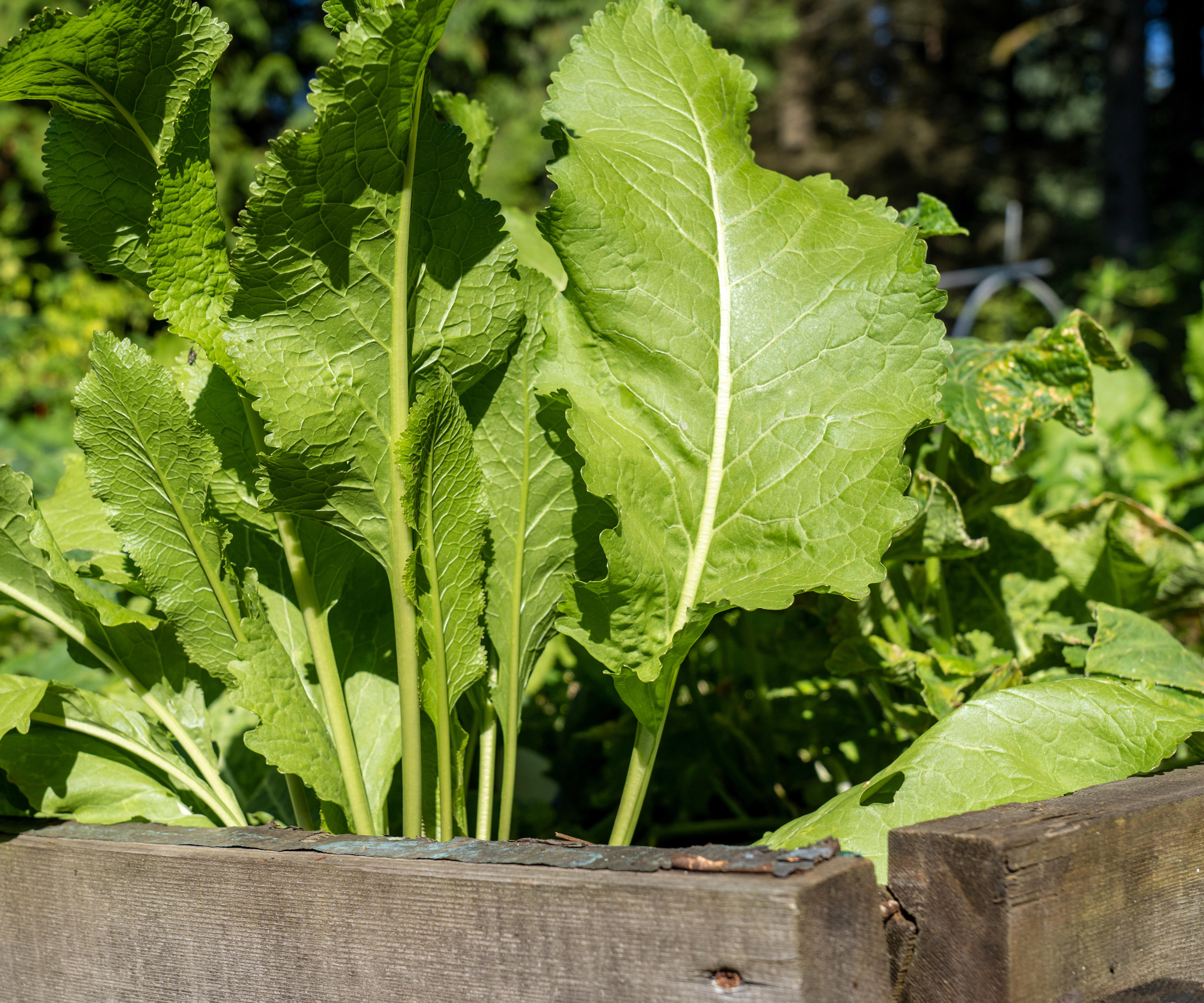
Horseradish can be vigorous growers so keep them in a separate area or raised bed to manage growth
When and how to grow horseradish
If you’re growing horseradish in areas where hard winters lead to extended periods of freezing, it’s a good idea to plant in March or April. However, planting in November is also good in areas where extremes of cold are less likely to occur. As long as the ground isn’t frozen, it’s fine.
Planting in late fall when there is less activity on the plot gives emerging plants several months of fresh and cool weather, which they love, to get settled. A long growing season is preferred to develop these intricate networks of roots. As we have said, some exposure to frosts can also help improve the taste of the crops as it encourages the roots to produce more sugars. If you want to protect plants from frost at the early stages, though, you can always start them under cloches or cold frames.
Knowing how to grow horseradish is made simpler because you don’t need to start them off from seed. Instead, you’ll grow these crops from potted plants, bare roots (thongs) or small root cuttings (sets or crowns). There are two main types of horseradish: ‘common’ types, which have wide textured foliage, and ‘Bohemian’ varieties with narrower leaves. Common types of Armoracia rusticana are believed to have the tastiest roots, whereas Bohemian types have a higher level of disease resistance. Some popular varieties include:
- ‘Big Top Western’: This variety has been bred for its resistance to foliage diseases, rust and bacterial spot. Large roots and smooth leaves.
- ‘Bohemian Giant’: Great disease and pest resistance is guaranteed with this tasty Bohemian variety, with its fat roots and narrow leaves.
- ‘Maliner Kren’: This Bohemian horseradish type with its broad and crinkly leaves is very popular for making into gourmet sauces.
- ‘Variegata’: For a striking ornamental horseradish, this variety has creamy leaves splashed in dark green. Less invasive than other types.
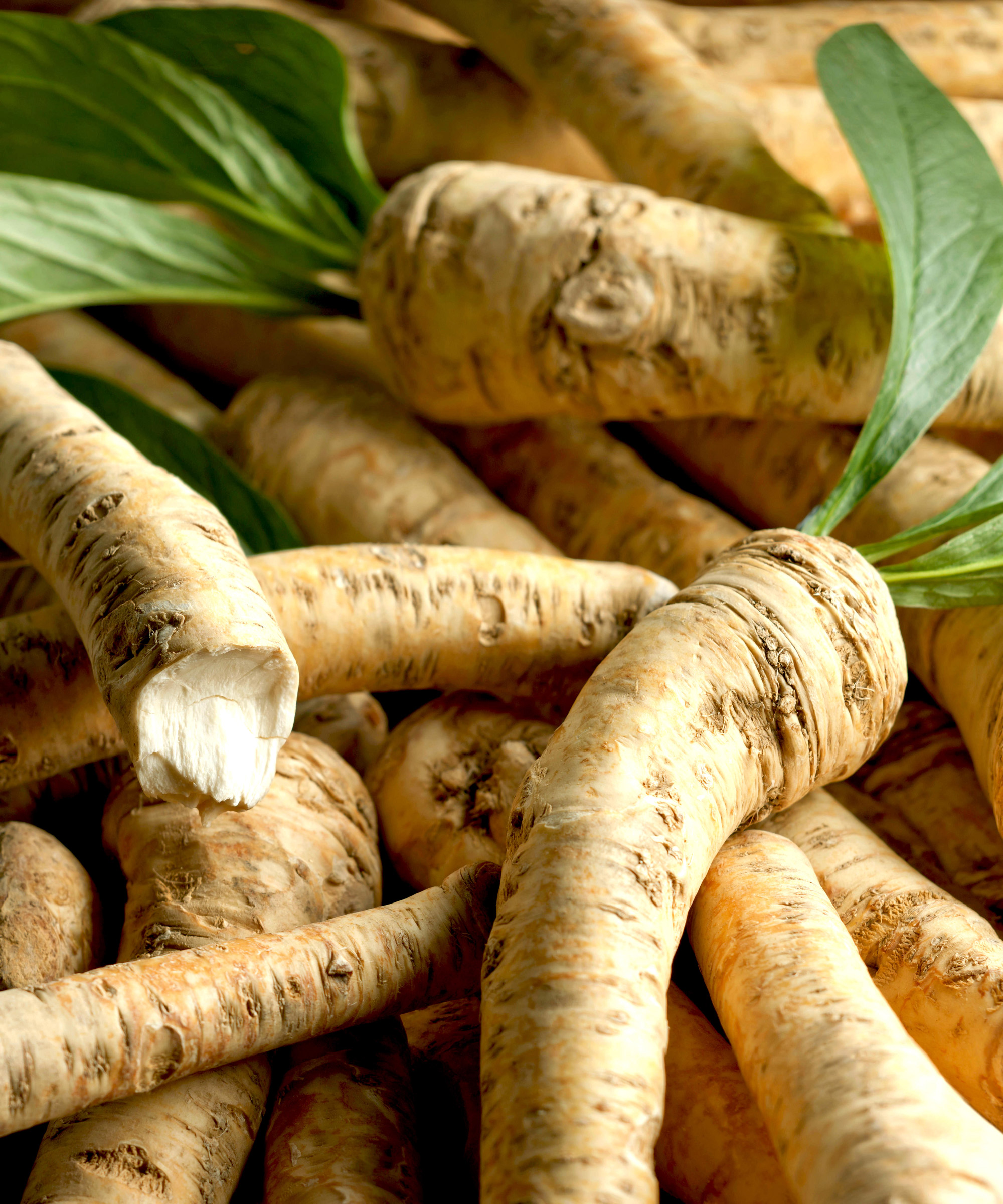
The large and tasty roots of Armoracia rusticana
How to plant horseradish from root cuttings
For the quickest returns, it’s best to know how to grow horseradish from root cuttings. Before planting, check the ground is free from large stones, raking over the earth if necessary. Add a few inches of compost or organic material and controlled-release fertilizer a few weeks before planting. Also add a little sand to the earth to give the soil a loose and ‘silty’ quality. When planting, make sure the root is a few inches deep and at a 45˚ angle. Space multiple cuttings at least a foot apart, and make sure the bed has a sturdy border to stop spreading.
After planting, cover with top soil, water in well and add a light mulch, and you’re done. However, you can also plant your root cuttings in a tray under cover. This is ideal if you want more small vegetable garden ideas and need to maximize space. As Amateur Gardening’s veg expert Lucy Chamberlain indicates, this is also a good way of regulating starting conditions if you are worried about frosts striking in the early stages.
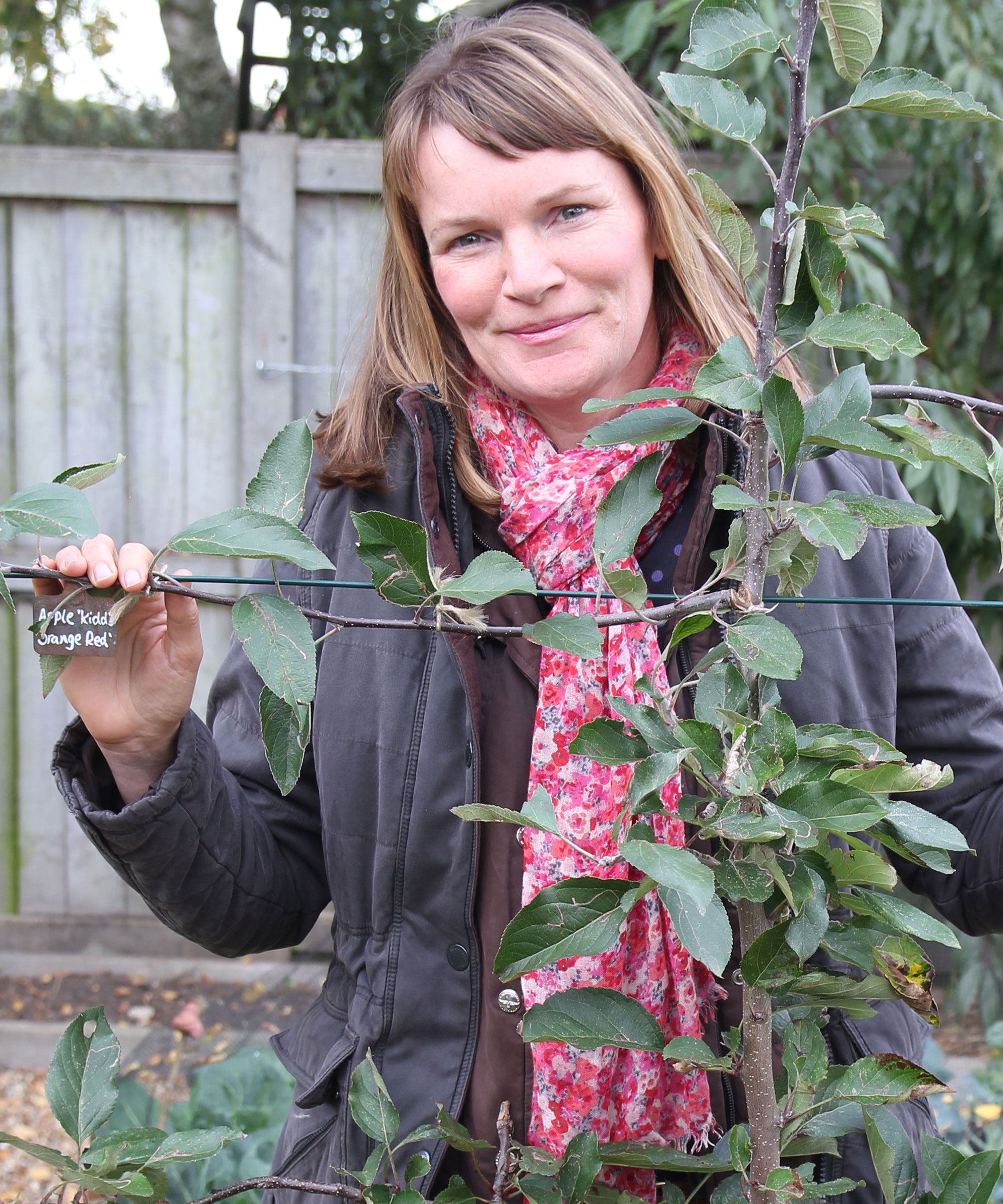
Lucy was a Horticultural Advisor at RHS Wisley and has been Head Gardener on a 100-acre estate in England for many years, but writes regularly for titles such as The Garden, Gardeners’ World, The Guardian and Amateur Gardening. She’s also the author of RHS Step by Step Veg Patch, which covers 50 types of fruit and veg. Here she offers advice on propagating horseradish under cover from existing root cuttings:
- Identify a healthy, true-to-type parent plant and gently excavate it with a garden or hand fork. Slice off 8in lengths of vigorous, young root and replant the main parent clump. Make sure the top end of each cutting is flat, with the bottom angled. Clean and dry the cuttings.
- Part-fill a seed tray with a gritty, free-draining seed compost. Water well and allow it to drain. Cut the roots into 3in long sections. Lay on the compost surface but angle the cuttings slightly, with flat ends uppermost. Cover with 1in of compost, watering well again.
- Lay the tray in a frost-free, well-lit spot; greenhouse staging is ideal. Keep the compost just moist for the best chance of propagation – a clear lid can help with this. (You could also use moist sand if you don’t have compost.) Come spring, shoots should appear.
- Carefully separate out the cuttings and move into individual pots or plant out into full sun. Make sure the soil is prepared as explained above. When planting out, you can reduce the risk of plants spreading out of control by planting the roots in a deep bucket in the ground.
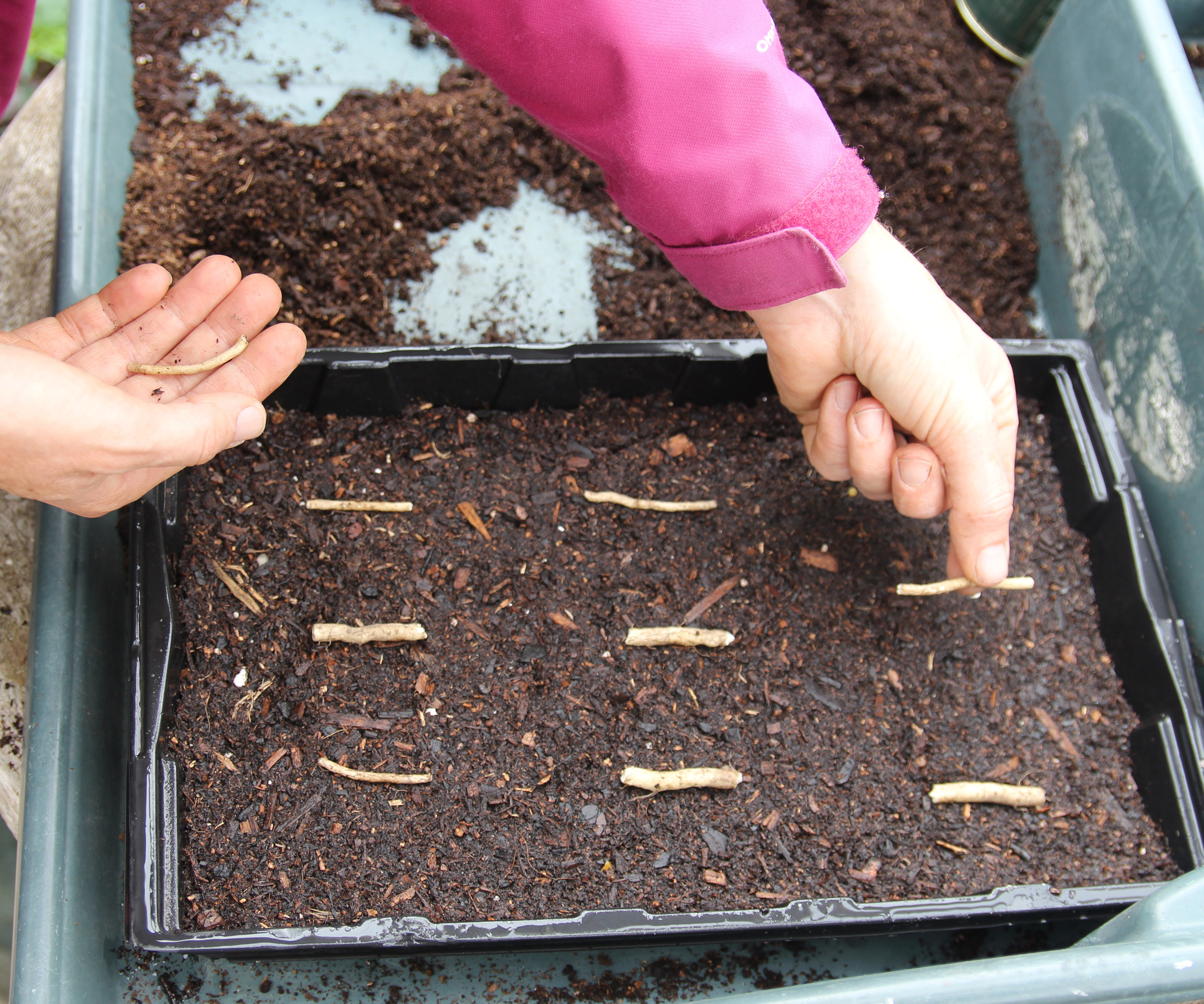
Propagate new plants from root cuttings – angling cuttings is advised, checking the top end is flat and the bottom pointed
How to grow horseradish in containers
Growing horseradish in containers is recommended if you have a small backyard and several other crops to consider. As we have already pointed out, it is a vigorous plant and can spread rapidly if left unchecked. In open ground, it is said the roots can reach 10ft deep – and even the tiniest amount of root left in the ground after harvesting can sprout again. Opting for container gardening is the best way to keep horseradish from taking over your kitchen garden space.
If you are looking to incorporate horseradish into vegetable garden container ideas, just make sure the container is as large (and as deep) as possible, with a minimum 15in diameter and preferably a 30-35in depth. As Lucy Chamberlain points out, the best way to utilize your containers is to sink them into the ground to keep plant growth in check. This also helps to keep the roots cool and moist, which they love. However, any large outdoor planters or five-gallon buckets or half-barrels will give horseradish ample room to thrive without encroaching on other crops.
As with planting in the ground, plant with the thongs or sets at a 45˚ angle. Ensure the top is a few inches below the compost surface. Three per pot is fine. Firm in, add a light mulch and water in. Grow on in sun or partial shade. Make sure your planter or pot has drainage holes. Unglazed clay or terracotta allow excess moisture to evaporate quicker.
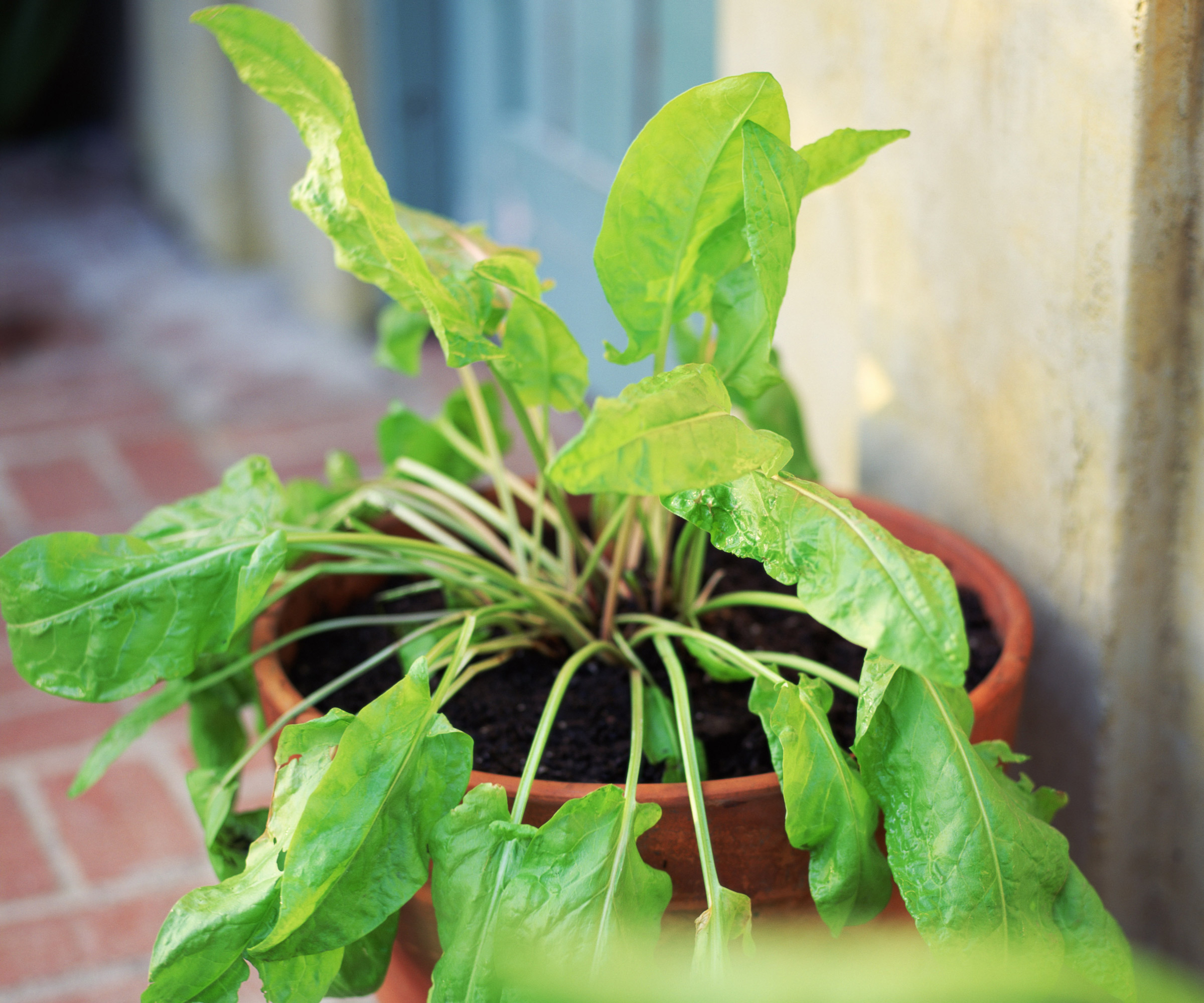
To prevent horseradish taking over, you may prefer to grow it in pot, but move to a large container as it develops
Caring for horseradish
Once you know how to grow horseradish, it is quite straightforward to care for. If it is kept in a cool, sunny and contained environment, there isn’t much to worry about. The main priority is hydration, so water plants regularly (not too much) during the growing season. Keeping the soil or compost cool stops roots from becoming dry and woody, and a light mulching helps with this. Replenishing organic material at intervals over the year will keep plants healthy.
Give plants a balanced controlled-release liquid feed during the growing season. Horseradish appreciate an application of nitrogen fertilizer at monthly intervals after planting. As long as your plants receive at least six hours of sunshine a day, there isn’t much else to do. Weeding can help as plants establish, but take care when plants are young as you might disturb the root systems. Also, unlike other plants, you don’t need to remove flower heads. However, to keep plants productive, it’s a good idea to lift and divide clumps every few years, then replant them.
Although horseradish are best kept separate from other ground-based plants, they are beneficial as insect repellents for a variety of crops. So if you enjoy companion planting, keep some container-based horseradish near rhubarb, strawberries, asparagus and potatoes. While this won’t help the horseradish, it boosts the health of its companions no end.
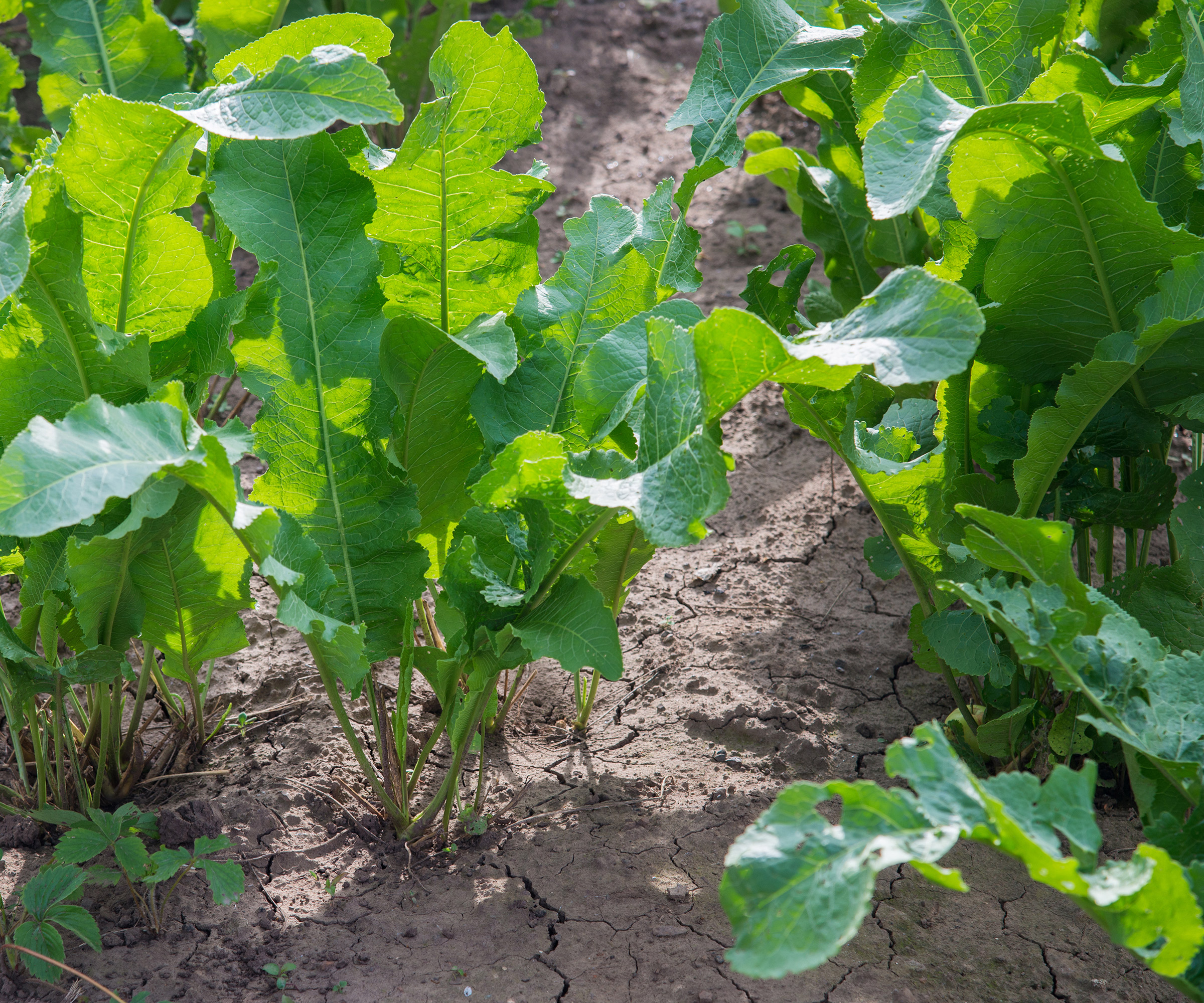
Watering is a fine balancing act, as plants are drought resistant but roots taste better with hydration
Problems growing horseradish and how to solve them
The good news is that growing horseradish is unlikely to lead to many problems. There aren’t many pests or diseases to worry about, partly because of its hardy nature and partly because it is so pungent! Unless plants are overwatered, you shouldn’t be blighted by diseases such as root rot. And of the pests that do appear, most can be addressed without sacrificing plant yield or root quality. Just watch out for the following:
- Aphids: Beware yellow, distorted, sticky or fallen leaves. You can get rid of aphids by introducing beneficial predators like lacewings and ladybirds. Spraying soapy water on leaves can also control numbers.
- Cabbage worms: Look out for foliage with large, uneven holes or yellow eggs on the reverse. Control numbers by handpicking pests and removing damaged leaves, and prevent with horticultural mesh.
- Slugs/snails: The most likely pest will announce their presence with slime trails and distinctive holes in foliage. You can get rid of snails by treating with organic pellets, beer traps or picking off culprits by hand.
- Flea beetles: One of the tell-tale signs of this pest are the appearance of tiny holes in the leaves on which they feed. Prevent with horticultural mesh, and tackle with organic insecticides.
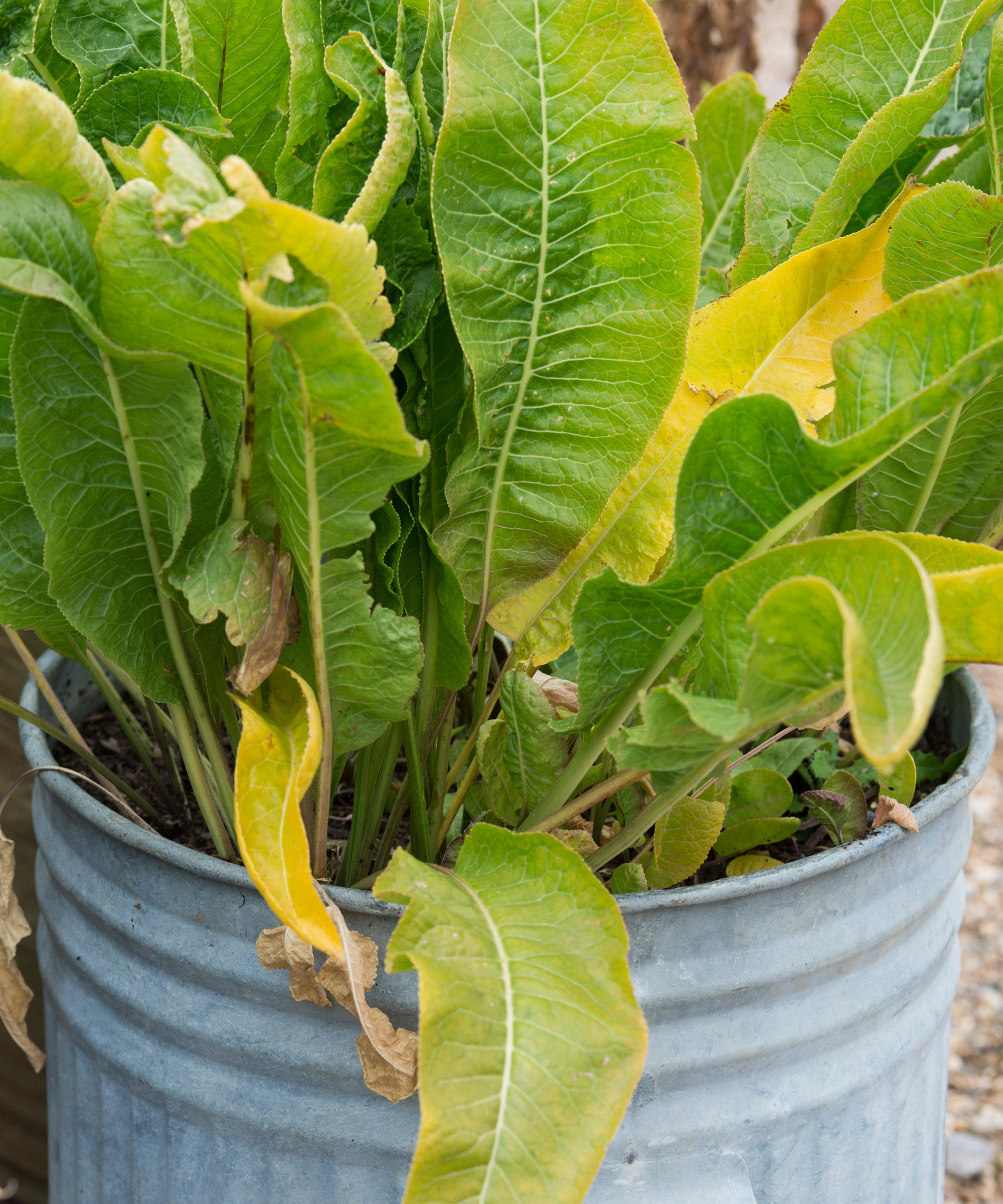
While happy growing in large containers, keep an eye out for too many yellowing leaves which may be a sign of aphids
FAQs
Can I grow horseradish from seed?
Technically, you can grow from seed as you would if you grow carrots, but horseradish needs a long growing season. In most areas, it wouldn’t be ready for harvesting at the right time if started from seed, even early. If you try, use organic pots you can transplant directly into the ground so as not to interfere with developing roots. In most cases, it is easier to start horseradish from plants, thongs or cuttings, as outlined above.
Can you leave horseradish in the ground over winter?
If you wish to grow horseradish as a perennial, you can leave horseradish in the ground over winter if sown in late fall or in winter – and harvest the following fall. However, if sown in the spring, it is best to harvest horseradish just after the first frost. Horseradish takes around eight-10 months to fully grow, so don’t leave in the ground over winter if you sowed the previous spring, as this will result in tough and bitter roots.
Is horseradish related to wasabi?
Wasabi is called ‘Japanese horseradish’ but is a different plant (Wasabia japonica). However, if you eat wasabi sauce outside of Japan, chances are your sauce was made with horseradish! Both are part of the same family (Brassicaceae), but wasabi plants are fussier to grow and require cool, damp conditions to flourish, so they will struggle in dry zones.
By contrast, horseradish is more easy-going and so it makes a fine stand-in (coupled with mustard) if you are interested in Japanese garden ideas and you’re keen on wasabi flavors in your cooking.
Is horseradish invasive?
Because it is vigorous, horseradish does have a tendency to take over and can be hard to remove once established. They can grow again from tiny bits of root left in the ground, and have a reputation for being invasive plants if left unchecked, but can be kept in line if grown in a raised bed or container. As an alternative to horseradish, Amateur Gardening’s organic expert Bob Flowerdew recommends growing relative spoonwort or ‘scurvy grass’ (Cochlearia officinalis), which has a similar taste.
Sign up to the Homes & Gardens newsletter
Design expertise in your inbox – from inspiring decorating ideas and beautiful celebrity homes to practical gardening advice and shopping round-ups.

As assistant editor of Amateur Gardening magazine, Janey's gardening passion was fostered from an early age, when her amazing mum had her deadheading hydrangeas, mulching roses, and propagating strawberry plants from runners for school open days. She's also taken part in lots of conservation and rewilding projects for the RHS and TCV as a way of exploring her horticultural horizons.
- Holly ReaneyContent Editor and Sub-editor
-
 Charli XCX's dining room is a 'treasure-trove' of one-of-a-kind pieces – it's the most unique hosting space I've ever seen (and surprisingly replicable)
Charli XCX's dining room is a 'treasure-trove' of one-of-a-kind pieces – it's the most unique hosting space I've ever seen (and surprisingly replicable)The singer's Tudor-style dining room features eclectic furnishings, a mix of patterns and bright colors that all work together beautifully
By Hannah Ziegler Published
-
 The 5 worst things you can do to your fridge – these will drive up energy costs and result in pricey and regrettable repairs
The 5 worst things you can do to your fridge – these will drive up energy costs and result in pricey and regrettable repairsIt's crucial to swerve these blunders, appliance experts warn
By Ottilie Blackhall Published